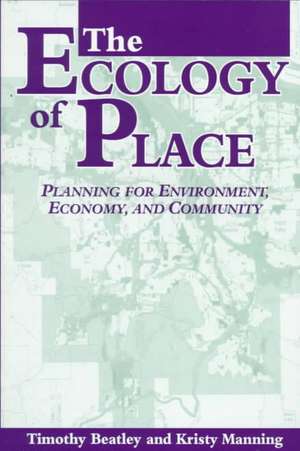The Ecology of Place: Planning for Environment, Economy, and Community
Autor Timothy Beatley, Kristy Manningen Limba Engleză Paperback – 30 noi 1997
Current patterns of land use and development are at once socially, economically, and environmentally destructive. Sprawling low-density development literally devours natural landscapes while breeding a pervasive sense of social isolation and exacerbating a vast array of economic problems. As more and more counties begin to look more and more the same, hope for a different future may seem to be fading. But alternatives do exist.
The Ecology of Place, Timothy Beatley and Kristy Manning describe a world in which land is consumed sparingly, cities and towns are vibrant and green, local economies thrive, and citizens work together to create places of eduring value. They present a holistic and compelling approach to repairing and enhancing communities, introducing a vision of "sustainable places" that extends beyond traditional architecture and urban design to consider not just the physical layout of a development but the broad set of ways in which communities are organized and operate. Chapters examine:
The Ecology of Place is a timely resource for planners, economic development specialists, students, and citizen activists working toward establishing healthier and more sustainable patterns of growth and development.
The Ecology of Place, Timothy Beatley and Kristy Manning describe a world in which land is consumed sparingly, cities and towns are vibrant and green, local economies thrive, and citizens work together to create places of eduring value. They present a holistic and compelling approach to repairing and enhancing communities, introducing a vision of "sustainable places" that extends beyond traditional architecture and urban design to consider not just the physical layout of a development but the broad set of ways in which communities are organized and operate. Chapters examine:
- the history and context of current land use problems, along with the concept of "sustainable places"
- the ecology of place and ecological policies and actions
- local and regional economic development
- links between land-use and community planning and civic involvement
- specific recommendations to help move toward sustainability
The Ecology of Place is a timely resource for planners, economic development specialists, students, and citizen activists working toward establishing healthier and more sustainable patterns of growth and development.
Preț: 198.94 lei
Nou
Puncte Express: 298
Preț estimativ în valută:
38.07€ • 38.99$ • 31.67£
38.07€ • 38.99$ • 31.67£
Carte indisponibilă temporar
Doresc să fiu notificat când acest titlu va fi disponibil:
Se trimite...
Preluare comenzi: 021 569.72.76
Specificații
ISBN-13: 9781559634786
ISBN-10: 1559634782
Pagini: 278
Dimensiuni: 152 x 229 x 20 mm
Greutate: 0.38 kg
Ediția:None
Editura: Island Press
Colecția Island Press
ISBN-10: 1559634782
Pagini: 278
Dimensiuni: 152 x 229 x 20 mm
Greutate: 0.38 kg
Ediția:None
Editura: Island Press
Colecția Island Press
Notă biografică
Timothy Beatley is a professor in the Department of Urban and Environmental Planning at the University of Virginia in Charlottesville, Virginia. His books include Green Urbanism (Island Press, 2000), An Introduction to Coastal Zone Management (Island Press, 1994) and Habitat Conservation Planning (University of Texas Press, 1994).
Kristy Manning was an independent writer and consultant based in Chapel Hill, North Carolina.
Kristy Manning was an independent writer and consultant based in Chapel Hill, North Carolina.
Cuprins
Acknowledgments
Chapter 1. The New Planning Agenda
Chapter 2. Envisioning Sustainable Places
Chapter 3. Principles of Urban Form
Chapter 4. The Ecology of Place
Chapter 5. Building A Restorative Economy
Chapter 6. The Civic Community
Chapter 7. Getting There from Here: Starting Points and Future Directions
Bibliography
Index
Chapter 1. The New Planning Agenda
Chapter 2. Envisioning Sustainable Places
Chapter 3. Principles of Urban Form
Chapter 4. The Ecology of Place
Chapter 5. Building A Restorative Economy
Chapter 6. The Civic Community
Chapter 7. Getting There from Here: Starting Points and Future Directions
Bibliography
Index
